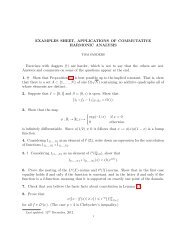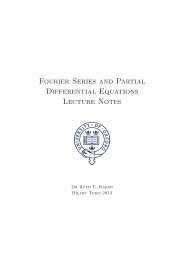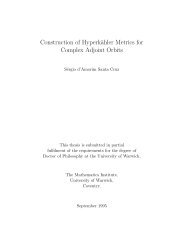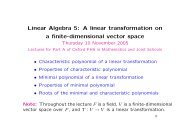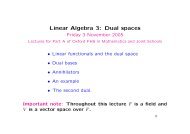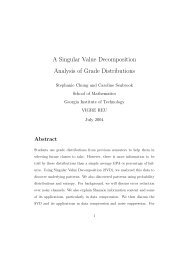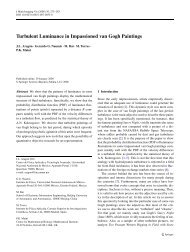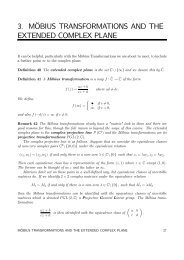Chapter 8. Chebyshev spectral methods
Chapter 8. Chebyshev spectral methods
Chapter 8. Chebyshev spectral methods
You also want an ePaper? Increase the reach of your titles
YUMPU automatically turns print PDFs into web optimized ePapers that Google loves.
<strong>8.</strong>3. CHEBYSHEV DIFFERENTIATION BY THE FFT TREFETHEN 1994 273<br />
In generalization of the fact that the real part of z is x, the real part of z n (n 0)<br />
is T n(x), the <strong>Chebyshev</strong> polynomial of degree n. This statement can be taken as a<br />
de nitionof<strong>Chebyshev</strong> polynomials:<br />
T n (x)=Rez n = 1 2 (zn +z ;n ) = cos n (8:3:3)<br />
where x and z and are, as always, implicitly related by (<strong>8.</strong>3.1).* It is clear that (<strong>8.</strong>3.3)<br />
de nes T n (x) tobesome function of x, but it is not obvious that the function is a polynomial.<br />
However, a calculation of the rst few cases makes it clear what is going on:<br />
T0 (x) =1 2 (z0 +z ;0 )=1<br />
T1 (x) =1 2 (z1 +z ;1 )=x<br />
T2 (x) =1 2 (z2 +z ;2 )= 1 2 (z1 +z ;1 ) 2 ;1=2x 2 ;1<br />
T3 (x) =1 2 (z3 +z ;3 )= 1 2 (z1 +z ;1 ) 3 ; 3 2 (z1 +z ;1 )=4x 3 ;3x:<br />
In general, the <strong>Chebyshev</strong> polynomials are related by the three-term recurrence relation<br />
T n+1 (x)= 1 2 (zn+1 +z ;n;1 )<br />
= 1 2 (z1 +z ;1 )(z n +z ;n ); 1 2 (zn;1 +z ;n+1 )<br />
=2xT n(x);T n;1(x):<br />
By (<strong>8.</strong>3.2) and (<strong>8.</strong>3.3), the derivative ofT n(x) is<br />
T 0<br />
n(x)=;n sin n d n sin n<br />
=<br />
dx sin<br />
(8:3:4)<br />
(8:3:5)<br />
: (8:3:6)<br />
Thus just as x, z, and are equivalent, so are T n (x), z n , and cos n . By taking linear<br />
combinations, we obtain three equivalent kinds of polynomials. A trigonometric polynomial<br />
q( ) of degree N isa2 -periodic sum of complex exponentials in (or equivalently,<br />
sines and cosines). Assuming that q( )isaneven function of , it can be written<br />
NX<br />
NX<br />
q( )= 1 2 an (e<br />
n=0<br />
in +e ;in )= an cos n : (8:3:7)<br />
n=0<br />
A Laurent polynomial q(z) of degree N is a sum of negative and positive powers of z up<br />
to degree N. Assuming q(z)=q(z) for z 2 S, it can be written<br />
NX<br />
q(z)= 1 2 an(z n=0<br />
n +z ;n ): (8:3:8)<br />
An algebraic polynomial q(x) of degree N is a polynomial in x of the usual kind, and we<br />
can express it as a linear combination of <strong>Chebyshev</strong> polynomials:<br />
NX<br />
q(x)= anTn(x): (8:3:9)<br />
n=0<br />
*Equivalently, the <strong>Chebyshev</strong> polynomials can be de ned as a system of polynomials orthogonal on<br />
[;1 1] with respect to the weight function (1;x 2 ) ;1=2 .




